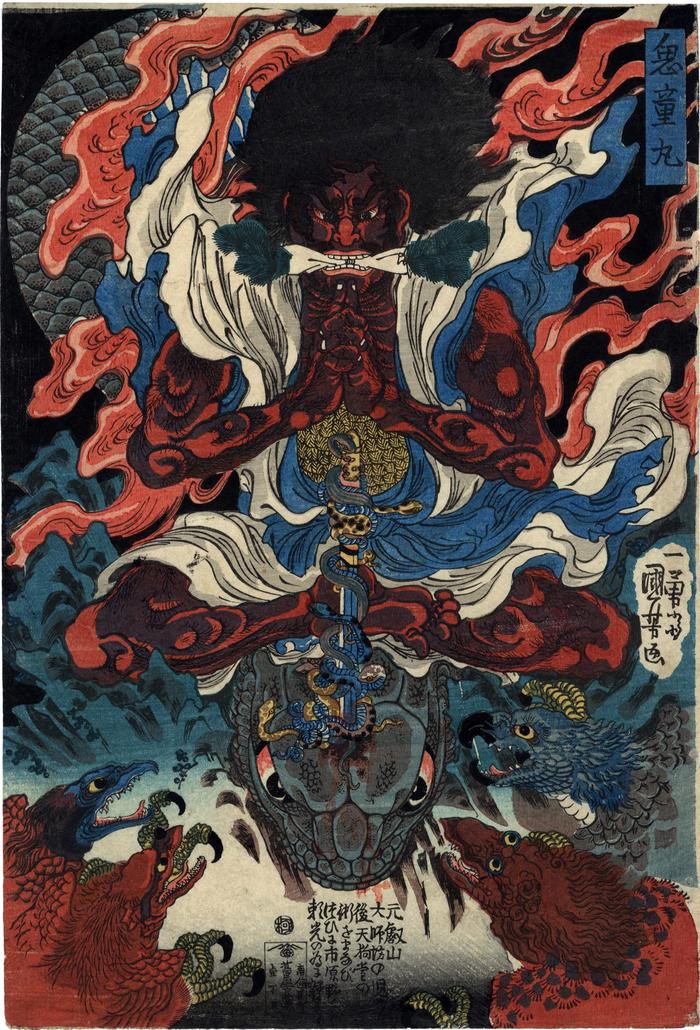Utagawa Kuniyoshi (歌川国芳) (artist 11/15/1797 – 03/05/1861)
Kidōmaru (鬼童丸) and the Tengu
ca 1840
10.125 in x 14.875 in (Overall dimensions) Japanese color woodblock print
Signed: Ichiyūsai Kuniyoshi ga
一勇斎国芳画
Publisher: Tsutaya Kichizō
(Marks 556 - 23-059)
Censor's seal: kiwame
British Museum
Museum of Fine Arts, Boston
Waseda University
Lyon Collection - a similar Kuniyoshi from 1852 of Inuyama Dōsetsu
Nationaal Museum van Wereldculturen (Rijksmuseum Volkenkunde, Leiden) - via Ritsumeikan University "Kidō-maru seated cross-legged on the head of a giant python, his hands clasped and two wrapped pine-sprigs in his mouth, a dirk has been driven into the head of the python, around which small snakes are writhing while four tengu watch."
Quoted directly from the curatorial files at the British Museum.
****
"Kidōmaru is known as both a robber and a magician... The instruction that he receives here from the tengu can only be described as a sort of mystical experience involving self-purgation - he accesses a side of himself that he hitherto was not fully aware of. This Kidōmaru is not derived from the usual source, the Zen Taiheiki, rather he seems to be inspired by Takizawa Bakin's yomihon, Shitennō shōtō iroku (Strange Story of the Eradication of the Wicked Four Retainers,1806). In this yomihon, Kidōmaru competes in practicing magic with Hakamadare Yasuuke. Kidōmaru conjures up a poisonous serpent, whereas Yasuuke produces an eagle.
In this print the head of the giant python is almost as arresting as the countenance of Kidōmaru and provides a second strong focal point. The aomatsuba (wrapped pine sprigs) likewise command the viewer's attention, as do other elements such as the flames and the small writhing snakes. The colours in this print are riveting in their bold juxtaposition of blue and red.
There are two types of tengu, one is winged but has a human face with a very long nose (yamabushi or 'mountain priest' tenfu), the other has a bird's head and a strong, curved beak (karasu or 'crow' tengu). Four fo the latter type inhabit the bottom section of this image."
Quoted from: Japanese Warrior Prints 1646-1905 by James King and Yuriko Iwakiri, p. 269. There is a color illustration.
****
Illustrated:
1) in a full-page color reproduction in Kuniyoshi: The Warrior Prints by B. W. Robinson, Cornell University Press, Ithaca, 1982, pl. 12. S1f.1. Robinson noted that in early editions have a Tanaka censor seal. He also wrote: "...into the python's head a dirk has been driven, round which smaller snakes are writhing; four tengu watch from below."
2) in color in Japanese Yōkai and Other Supernatural Beings: Authentic Paintings and Prints of 100 Ghosts, Demons, Monsters and Magicians by Andreas Marks, Tuttle Publishing, 2023, p. 181. This exact print is the one illustrated in this volume.
3) in color in Japanese Warrior Prints 1646-1905 by James King and Yuriko Iwakiri, Hotei Publishing, 2007, p. 269, no. 149.
4) in color in Utagawa Kuniyoshi: 342 Color Paintings [sic] of Utagawa Kuniyoshi by Jacek Michalak, Kindle Edition, 2022, unpaginated.
****
There is also another copy of this print in the Rijksmuseum voor Volkenkunde, Leiden.
Tsutaya Kichizō (蔦屋吉蔵) (publisher)
warrior prints (musha-e - 武者絵) (genre)
Yūrei-zu (幽霊図 - ghosts demons monsters and spirits) (genre)
Kidōmaru (鬼童丸) (role)
Tengu (天狗) (genre)
